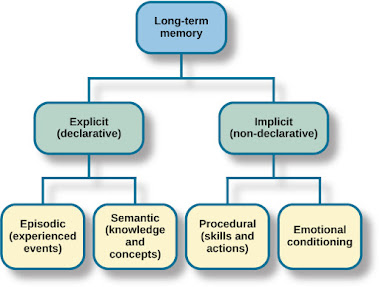I would like to give some of the neuroanatomy to you in this blog. It will allow you to have some visuals, and spend a bit of time delving in, if you so choose.
MEMORY
There is a wealth of information in the neuro and cognitive sciences about memory and learning that can be useful for understanding the most effective forms of education.
Memory is not a single construct.
There is short term and long term memory. We will talk about short term memory later, which is also not a single construct.
LONG TERM MEMORY
Explicit memory is also called Declarative Memory. Think about the fact that you can explain, or declare what you remember.
It is further divided into Semantic Memory and Episodic Memory.
Semantic Memory is all about categories of information.
Episodic Memory is memory for events.
We can also think of memory as passive and active. Active memory processes require the frontal lobe, while passive memory happens automatically without effort. It requires only open awareness. For students who have difficulties with executive function (which is to say most students under the age of 12) then we could benefit from including some of the more passive means of forming memories).
BRAIN
BASICS
ON THE LEFT we see the outer part of the brain. It is relatively homogeneous. This outer layer is called the CORTEX, which comes from the Latin root "bark" like bark of a tree. There are four primary cortical lobes.
The Frontal Cortex/Frontal Lobe is important in working memory and
executive function at the very front and is the start of the primary motor
cortex at the back, where it meets the parietal lobe.
The Parietal Cortex/Parietal Lobe is where the primary sensory inputs first
enter, just next to the frontal lobe, and integrates with the visual and
auditory information going back.
The Occipital Cortex/Occipital Lobe is where visual information first enters
the cortex, furthest back, and then integrates with the sensory and auditory
information in the two visual streams.
The Temporal Cortex/Temporal Lobe is where auditory information is
processed. It is also critical for social and emotional regulation and wraps
around two of our primary emotional brain regions, the Amygdala and Hippocampus.
THE
HIPPOCAMPUS
The
Hippocampus is an ancient brain regions. It has three cortical layers called archi-cortex.
Functionally it is part of the limbic (or emotional) brain but is tightly coupled to cognitive processing such as memory formation, pattern extraction,
and use of contextual cues.
The Hippocampus is critical in
declarative (conscious) memory formation and maps our location in space. It also plays an important role in time
perception.
The
Hippocampus has the unique property of producing new neurons throughout our
lifetime. These new neurons play an
important role in forming both fact-based, and episodic memories. This region has more neurons than any other single
nucleus in the brain, and it keeps making more. Wow! Is that cool, or what? As educators we really
should inform ourselves about this remarkable structure.
Special Populations in our Classroom
In trauma,
there is a reduction in the size of the hippocampus. This is one structure that has been studied
in depth because of its involvement in the stress response. It is an end target for the stress hormone
cortisol, and for nearly 20 years, it has been documented that this hormone
causes cell death in the hippocampus.
The findings in the animal literature support this, and it is also seen
consistently in adults with childhood trauma or PTSD. Volumetric changes are not seen in children,
but performance variables linked to the function of the hippocampus are
consistently reported in children. It
may be that anatomical changes are not noted in this resilient structure until
years of exposure to stress.



Comments
Post a Comment